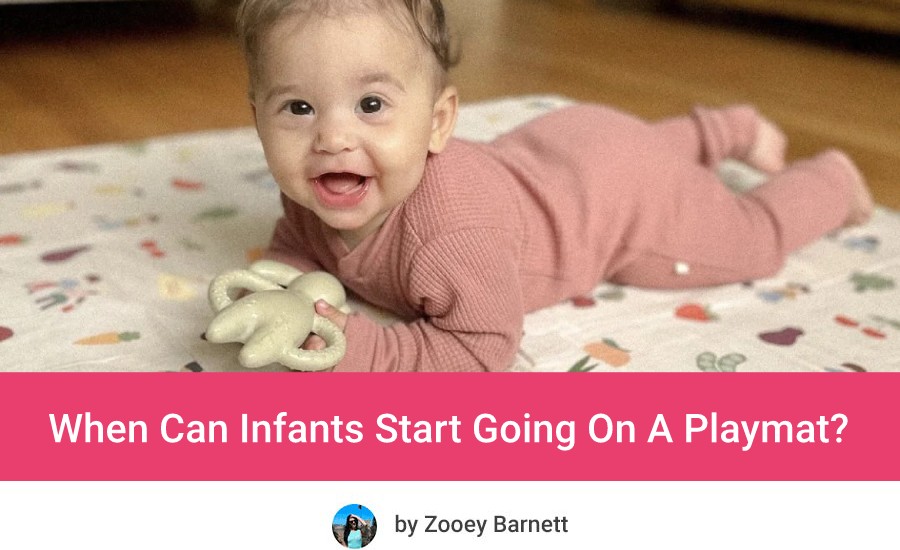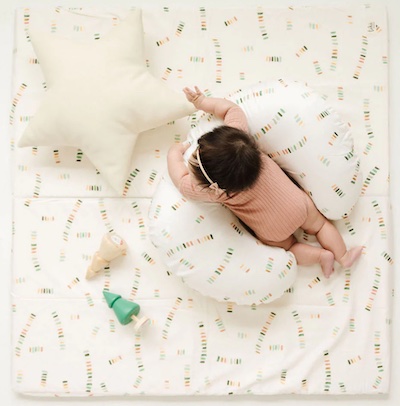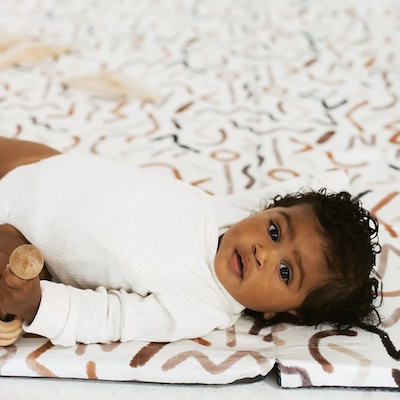Are you wondering what is the right time to get a play mat for your little one? Lots of parents are a bit hesitant about using it during first three months and feel a bit worried if it’s safe to put a newborn baby on a baby mat. In this article you’ll find safety tips and the answer to crucial question: When can infants start going on a playmat?

This article is not a substitute for medical advice.
Baby play mats come in different types. Choosing a play mat that is TOXIN-FREE, fits baby’s needs, as well as the baby’s room decor, isn’t actually that easy.
The importance of a play mat cannot be downplayed. Baby play mat helps encourage babies to develop essential skills that are necessary for crawling, scooting, sitting, standing up and eventually – walking.
It’s also a perfect place for building muscles strength and also practice fine motor skills (precise movements of a wrist and those sweet tiny fingers).
When still at their tender age, you don’t want your baby to play on a surface that may have germs – like a carpet or hardwood floor. So a play mat provides a clean and safe space for the baby to practice motor skills.
An infant can start going on a playmat from the first day, or you can wait until they are about 3 months old, but it’s good to start early.
What Is A Playmat?
A play mat is a flat padded surface that provides a safe and cozy space for tummy time and play time for babies.
While you might think you only need a play mat for tummy time, your baby could get many benefits from one.
Apart from muscle development, play mats provide sensory stimulation, nurture your child’s curiosity, and aid in cognitive development and fine motor skills.
There are several types of play mats, some are made from cotton, foam or latex, and they can be coupled with a baby gym with cute dangling toys.
But before you get excited and run out to get one, you need to know that there are toxic and non-toxic baby play mats.
When purchasing a play mat, ensure that you’re going for a non-toxic one. But how do you know that the play mat you’re about to pay for isn’t harmful to your child?
A good play mat should be free from the following:
- Glue
- BPA and BPS
- Polyurethane foam (PU foam)
- Polyurethane leather cover
- Flame retardants
- Formaldehyde
- Lead
- And other harmful materials
By the way, some brands advertise their PU foam playmats as safe and non-toxic, but please keep in mind that there is not such thing as NON-TOXIC PU FOAM!
At What Age Can My Baby Start Using A Playmat?
Your baby can start using a play mat even if they are one day old. However, some babies start to enjoy using the play mats once they get a bit older (about 3 months). Most babies get their attention on hanging toys, lights, and sounds at this stage.
So how do you know your baby is ready to use a play mat? If your baby can lie on the tummy without any complaints (fussiness) or you feel they need to practice tummy time, then you need the mat.
Keep in mind that during the first few weeks the tummy time shouldn’t last too long. Experts recommend 1-3 minutes per each tummy time session at first and about 10-15 minutes total in a day.
By the age of 3 month your little one will develop more head and neck control, as well as upper body strength, so you can expend tummy time then up to 30 minutes per day (split it into a few sessions).

Can You Put A Newborn Baby On A Play Mat?
Yes, you can. You can put your baby on a play mat as soon as you leave the hospital. But you need to understand that newborn babies can only practice tummy time for a few minutes each day and start to enjoy using the baby play mat from 3 months.
You can start practicing baby tummy from day one, but your baby might not like the idea until they can support their upper body.
Maybe you’re worried that it’s too early to start. I introduced tummy time to my boy when he was about 4 days old, and I feel it’s good to start early so the baby gets used to this new routine.
But you don’t have to go overboard with the sessions. A newborn may not appreciate the play mat or have fun. You must supervise the baby on the play mat at all time. A one to three minutes session is enough for a newborn.
When Should Baby Have Tummy Time On Play Mat?
If you’re planning to start tummy time with your newborn, start with 1 to 3 minutes sessions twice or thrice a day.
As the baby grows, you can extend the sessions to 15 minutes. By the time your baby hits 3 months and have stronger muscles tummy time gets fun. Around 4-6 babies should be able to rock themselves from side to side and later also roll over, and enjoy going on the playmat even more.
Tummy time can be done after a diaper change, after having a nap, or any time your baby is awake.
Is Baby Playmat A Must-Have?
A play mat is not a must-have, but it’s very useful and for every baby because it isn’t just about fun but also helps with a child’s development. It’s way more convenient and safer (CLEANER) to use than rug, blanket or bare floor.
Many parents know the importance of an activity mat and the role it plays in developing a baby’s milestones. Check out all the benefits below1 that will help you to decide whether you need a playmat for your baby:
1. A Safe Place For Rolling Over
Most play mats are made of protective foam and have a soft texture that helps your baby feel safe. The texture makes it easy for the baby to roll over and eventually sit away from hard surfaces.
2. Offers Baby The Freedom
The play mat is bigger than a baby crib and bassinet. For that reason, play mats offer the freedom needed by babies to roll around, kick freely and even scoot.
3. Convenience
It’s easy to set up a baby play mat in a park or at your friend’s home, all thanks to its lightweight and portable features. You fold it up, and you’re good to go.
4. Cognitive Developmental Benefits
You’ll wonder why a baby mat has bright colors, lights, and a soft texture. All these features play a significant role in stimulating and grabbing your baby’s attention.
5. Motor Skills
A play gym helps a baby develop fine motor skills as early as three months. Your baby will try to grasp objects hanging over the play mat.
6. Promotes Hand-Eye Coordination
Without a play mat, your child might take longer to develop hand-eye coordination because of a lack of interactions.
7. Muscle Development
Most babies will want to touch, kick and feel the dangling toys over their play gyms. You might see it as mere play, but this kind of play helps develop their muscles and gross motor skills.
8. Development Of Sense Of Touch
Play mats aid baby’s development in many ways, and the last one I’m talking about is a sense of touch. Because of the different textures of the baby gyms, soft toys, and fabrics, your child develops a sense of touch, which is an important way of interacting with the world.

Best Activities For Babies On Playmats
Apart from tummy time, you can engage your child in many other activities in a play mat and play gym. One thing I have to caution you about is avoiding toxic play mats.
Some mats are also too bright and loud and may cause overstimulation. I recommend you to avoid flashy play mats.
Get a simple play mat and add a wooden arch with dangling toys. Go for single toys or get black and white books that you can place in front of your child during tummy time.
1. Vision Skills
You can wear a puppet on one of your hands and move the hand as you call the baby’s name. Monitor to see if the baby is following along, then introduce more complex activities.
2. Communicate With Your Baby
Because you place the baby on a play mat when they are awake, this is the best time you can nurture communication skills with your child.
By the time the baby gets to three months, you will notice they try to make some sounds. Try to talk to your baby by responding to the sounds. This activity helps develop social skills.
3. Place Baby In Different Positions
It’s not about tummy and back positions only. I have noticed many parents pay attention to only these two positions.
You can teach your baby other positions by rotating the baby’s head to one side in clockwise and anticlockwise positions. This activity might seem like play, but it’s crucial for cognitive development.
How Long Can I Leave My Baby On A Playmat?
For newborns, you can limit sessions to 1-3 minutes (10-15 in total per day), and up to 30 minutes in total for older babies. As the baby’s muscles develop, they’ll start enjoying longer tummy time sessions.
Place your baby 3 to 5 times a day on the playmat for newborns until they get entirely used to tummy time. Then, you can increase the frequencies.
Always supervise baby on the play mat.
Keep in mind that playmat is designed for play time and awake times. It may happen that your baby falls asleep on play mat – then it’s best to move them to a safe sleeping space like crib, bassinet or pack n play.
How Long Will My Baby Use Playmat?
I had the same question in mind when I was getting my baby an activity mat. I was worried that we wouldn’t need the mat when he was used to crawling. However, we have had our playmat for years!
You can use your playmat for various activities: tummy time, crawling, scooting around, seated play, and it can also provide a nice, secure and comfy surface for play time throughout toddler years2.
Ways You Can Use A Playmat When Baby Grows Older
1. Turn It Into Your Yoga Mat
Do you love yoga like me? Who wouldn’t want to add an extra cushion to the carpet or tiled floor when doing yoga? And this is where the baby play mat comes in handy.
The baby play mat can also be an excellent surface for you when you’re exercising at home.
2. A Safe Place For Your Kids’ Play
Instead of letting your children sit on the cold floor or the carpet, you can spread the baby play mat for them to play.
After they are done running around and crawling, you can encourage your baby to sit on the mat and provide some toys for some play.
3. Place It Under The Feeding Chair
Most play mats are super easy to clean. I have, on several occasions, placed the playmat under the table when feeding my little one.
4. Use It As A Beach Mat Or On Picnics
When you decide to have some outdoor fun, you can use the mat for your picnics or on the beach. Luckily, most playmats are portable.
5. Turn It Into A Dog/Cat Mat
Speaking from my own experience our fluffy four-legged friend LOVE baby playmats, plus they provide a supportive surface for sleeping that is easy on their joints. It’s a win-win!
The purpose of this article is informative. It’s not a substitute for professional medical advice or medical care. Remember: safety first! Consult your doctor/pediatrician in case of any doubts. The author of this article does not accept any responsibility for any liability, loss or risk, personal or otherwise, incurred as a consequence, directly or indirectly, from any information or advice contained here.
Resources:
All pictures belong to Toki Mats brand: https://tokimats.com/.
Graham Jr, John M. “Tummy time is important.” Clinical Pediatrics 45.2 (2006): 119-121. https://www.researchgate.net/

